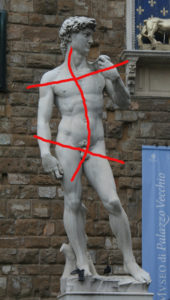Humanism is perspective of which an era of time valued the body’s capabilities. Most prevalent in the Ancient Greek Art era, the various sculptures carved had defining features only found within Ancient Greece. The idea that Man’s most valuable properties was their body’s structure and abilities became the main common feature among the large stone sculptures recovered from the area.
Ancient Greek and Egyptian Art share and differ in various ways. Among both groups of statues, both share similar human qualities like body structure and some forms of poses. They also differ in the way the body structure was modelled. In Egyptian Art, human figures were often sculpted and picture in a sideways view with some third dimension properties. This portrayed the figures to have their left foot in front of their right forming this semi-stable but uncomfortable position. In Ancient Greek Sculptures, male figures were sculpted in a form that they counter-balanced their weight with their limbs in different positions. This portrayal signifies the idea that humanism was highly valued. The body language of the male sculptures developed the form described as Contrapposto.


